7 Things to Ensure that Your Child is Actually Learning During Online Class
7 Things to Ensure that Your Child is Actually Learning During Online Class
Online education shapes how children learn today. It is a core part of many children's lives today. Seeing your child in an online class doesn't mean they are really learning. You can’t rely on attendance alone. Many parents wonder, "Is my child really learning or just staring at a screen?" We must implement strategies to answer this question and assess learning during online class. This guide outlines some key steps will help your child join online classes and learn like in a regular classroom. This way, they will enrich their learning experience and contribute to improving online learning outcomes.
Signs to Know If Your Child Is Really Learning During Online Class
How can you tell if the online programs are really working? You can tell by observing your child in a virtual classroom if they are truly learning. Learning during online class shows in activity, work, and participation. These signs lead to quality education and better outcomes. Such things matter because successful learning by students ensures quality education and success. Parents play a critical role when they monitor child's learning online, and they can also use online class engagement tips to keep their child focused and actively involved.
Explains concepts in their own words: Active learning strategies succeed when your child explains concepts in their own words.This shows they have processed the course materials, not just memorized facts. Ask them to teach you after a lesson. My niece once explained fractions: “It’s like slicing a pizza and sharing pieces” This shows child understands and remembers what she learned.
Completes tasks independently: Can they finish assignments or follow instructions without reminders? A self-motivated student finishes tasks on time. This shows that they understand their work and manage their time well. When your child does online homework without reminders, it means they are learning. They are not just wasting time on the screen.
Their questions show curiosity or deeper thinking: Are their questions about the lesson showing curiosity or trying to connect ideas? Good questions go beyond “What’s the answer?” They show creative thinking. For example, “Why do bees pollinate flowers?” shifts focus from memorizing to analyzing. This change is a key result of virtual learning and distance education.
They improve over time in output and focus: Watch their attention in class discussions and the quality of their work each week. Virtual education shows clear signs of better participation, output, and time management. Track test scores, class discussions, and assignment quality. If scores rise and work looks better, that implies your child applies new knowledge.
Noticeable progress in participation for each individual student, including those who actively participate, produce output, and improve time management skills indicates that the learning process in virtual education is effective for all students.
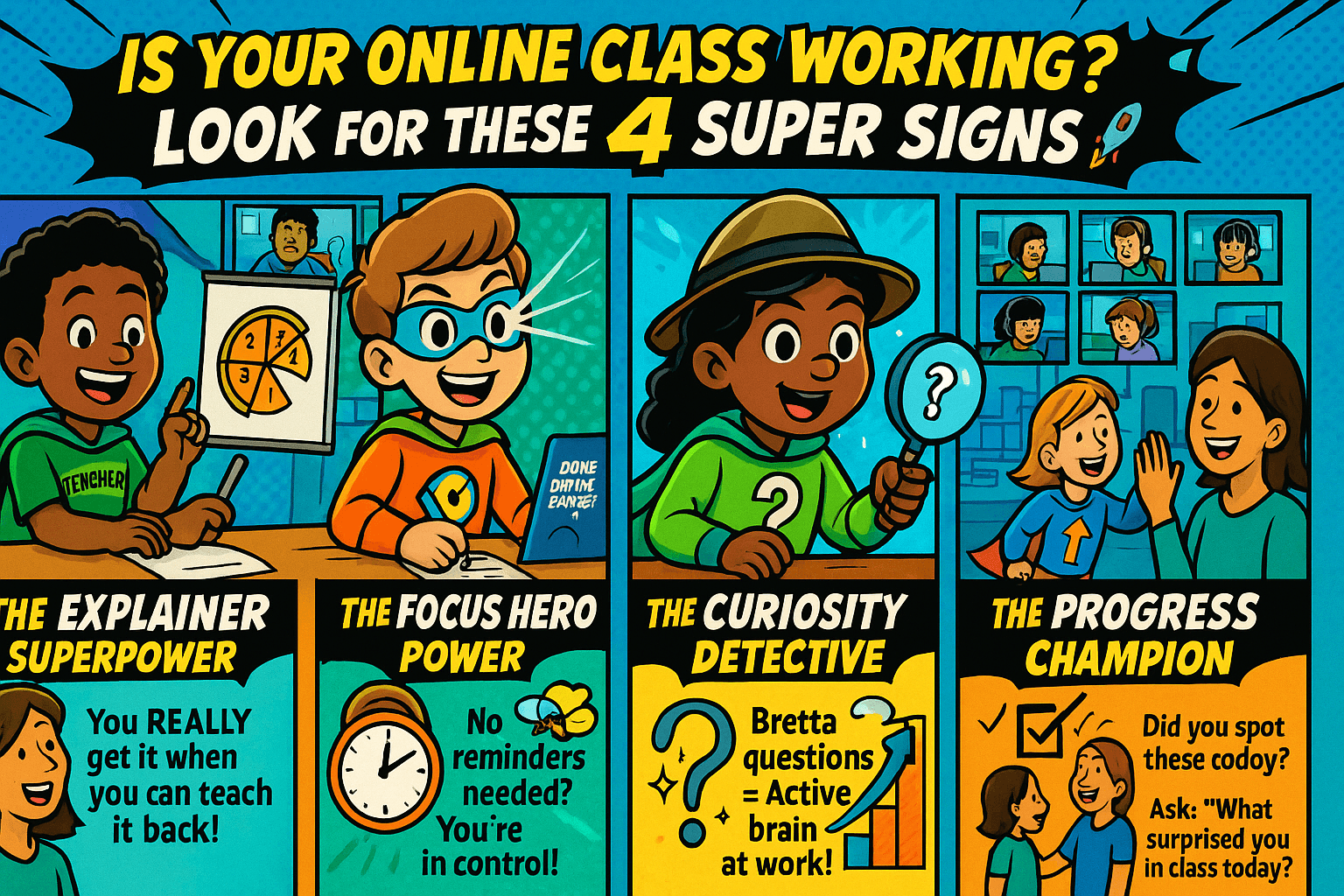
How to Monitor Your Child's Learning Online Without Micromanaging
Finding the balance between support and saturation is the key in online learning. You want to ensure success without hovering. Try these gentle methods:
Set weekly check-ins : Choose one hour or 15min each week to review course materials, check assignments, or see test scores.
Ask: “What did you learn this week? Which part did you find tough?” This blends time management skills and student work tracking.
Use platform dashboards: Most online courses provide parent dashboards. Review participation reports, completed assignments, and instructor feedback regularly.
Ask open-ended questions daily: Instead of "How was class?", ask specific, engaging questions like:
What’s one interesting thing you discussed with other students today?
Can you show me something new you learned in math/science?
What question did you ask (or want to ask) the teacher today?
Encourage self-reflection: Ask your child about their learning. Try, "What part of today’s lesson made you think?" or "What strategy helped you understand that topic?" This builds metacognition.
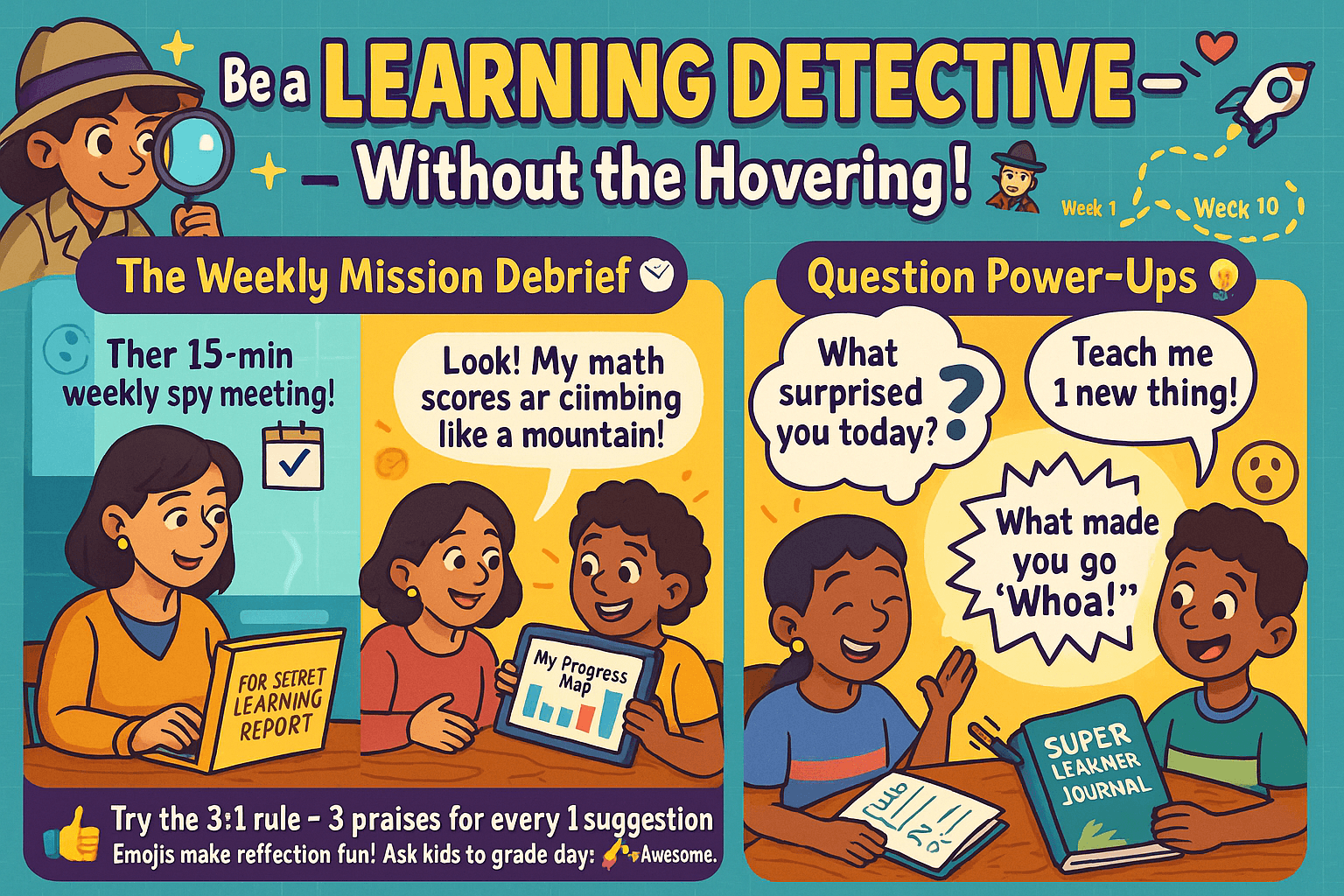
Online Class Engagement Tips That Actually Work
Active participation is the engine of learning duringonline learningclass. Passive screen-watching leads nowhere, students must actively participate. Boost online class engagement with these proven strategies that include providing timely feedback and teaching students to utilize discussion forums. These methods significantly improve virtual classroom effectiveness and contribute to improving online learning outcomes.
Offer controlled choices: Empower your child within limits. Let them choose:
Where: Provide 2-3 spots for online learning, like a desk or a kitchen table with a divider
When: For recorded course materials, be flexible with the schedule. For example: "Finish this module before dinner"
How: Let them choose their water bottle, pick a fidget tool (if allowed), or select background lighting.
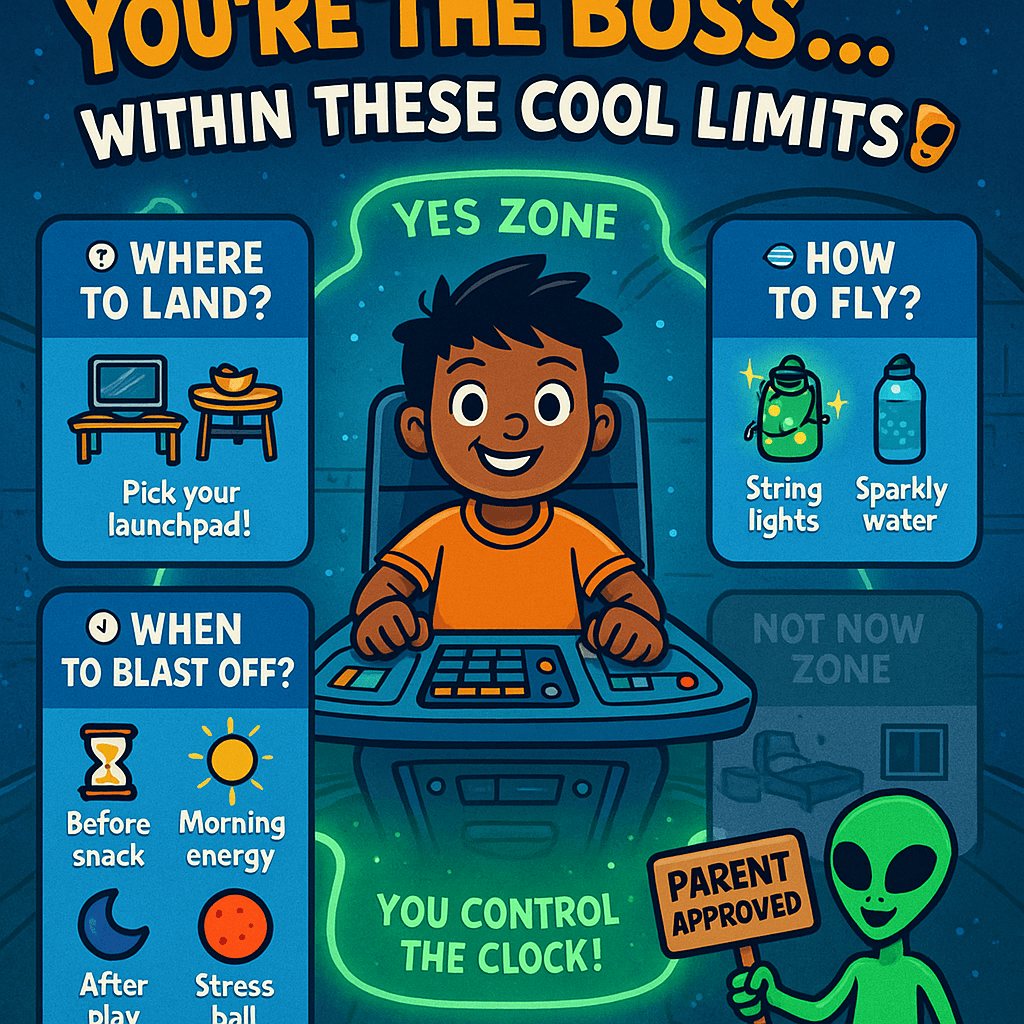
Implement visual trackers & rewards: Make participation visible and rewarding.
Use a simple chart to track when students raise their hands, answer questions or finish tasks on time
Give small, non-screen rewards for regular participation. For example, offer extra playtime or let them pick a family game
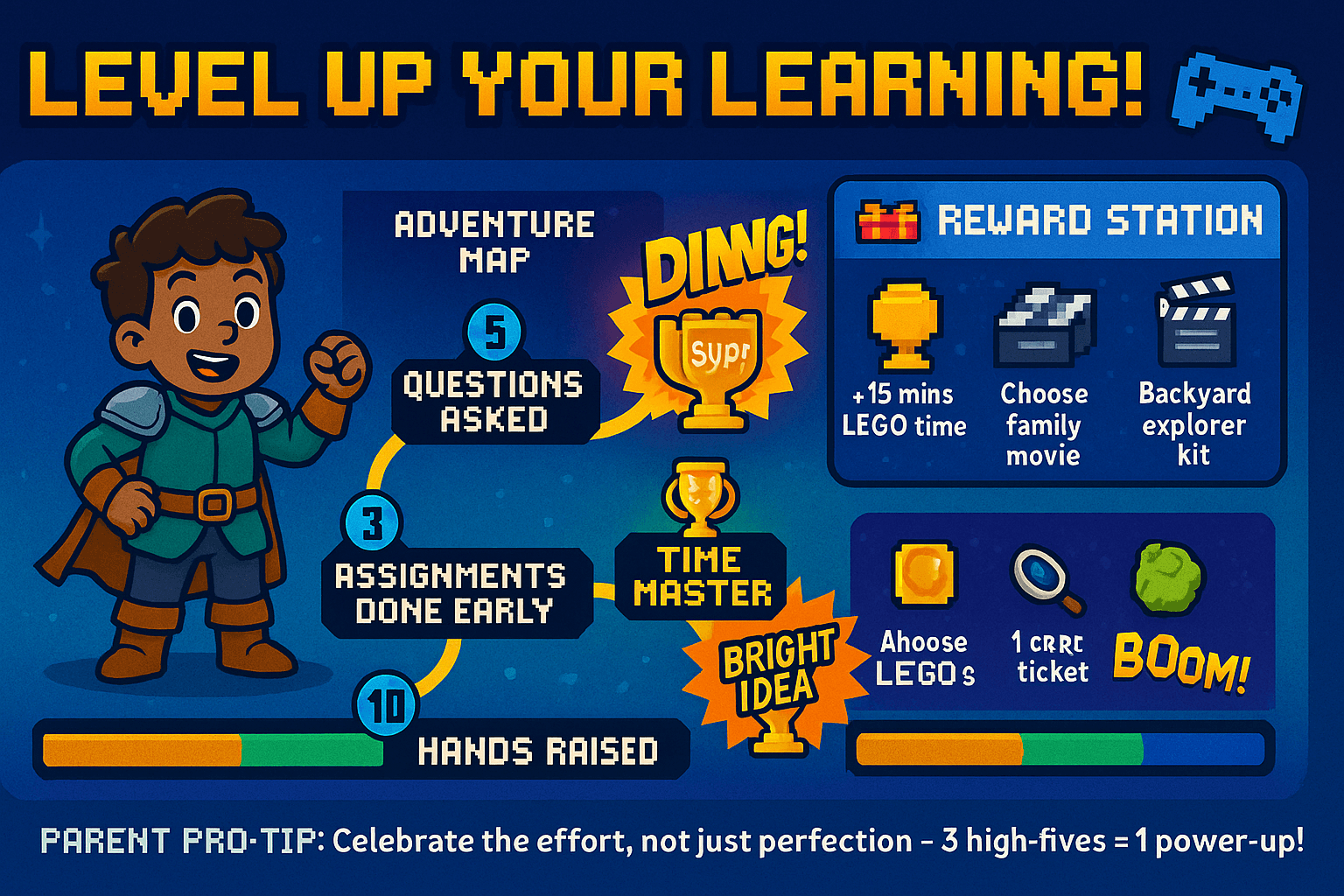
Schedule mandatory movement breaks: Fight against screen exhaustion to improve attention. Schedule 5-10 minute breaks every 30-45 minutes for:
Stretching, jumping jacks, or a quick dance
Brain Gym exercises like cross-crawls (touching the opposite hand to knee)
Getting a snack or looking out a window
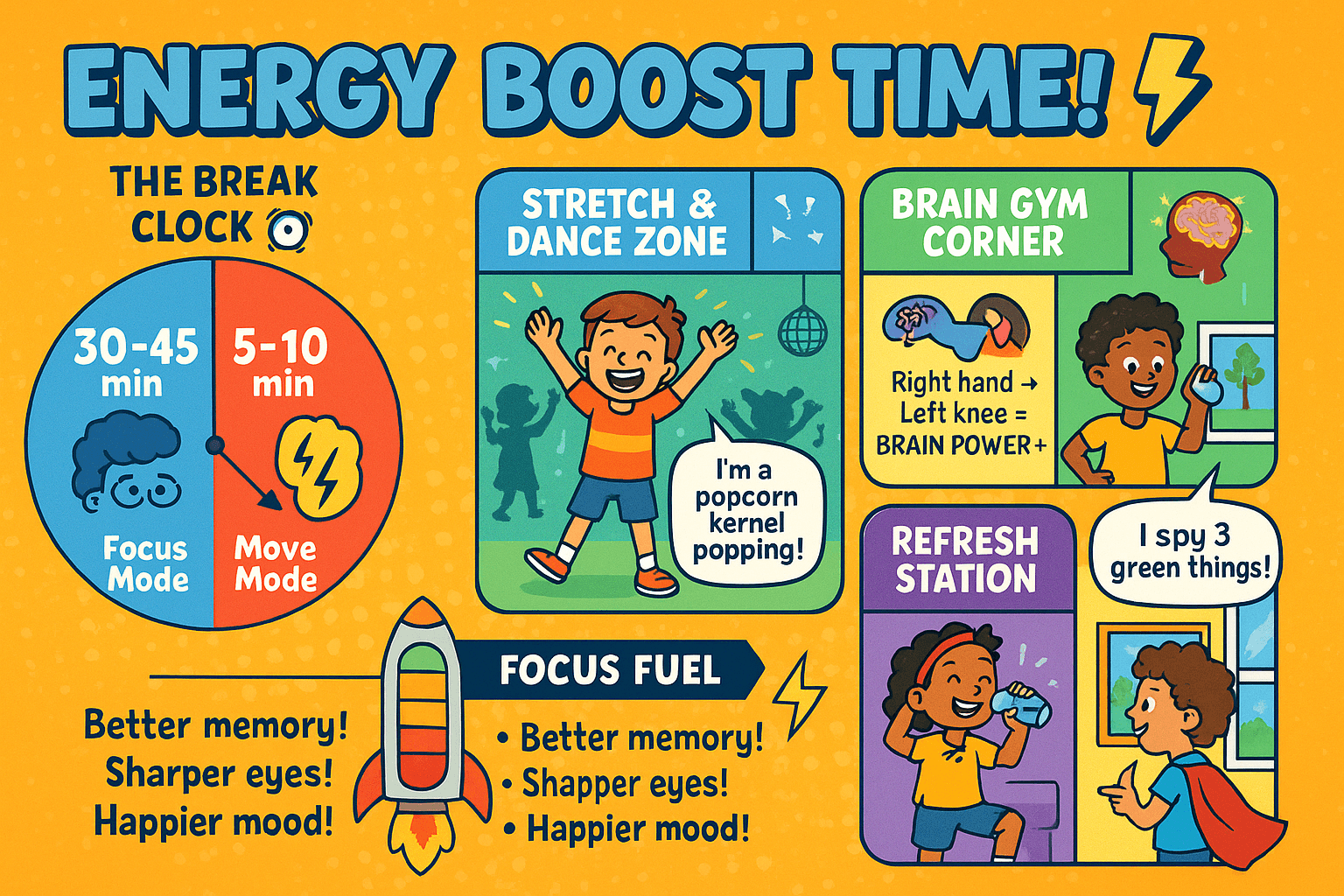
Reduce screen pressure (especially for younger students): Kids often feel anxious and distracted when they see themselves all the time.
Show your child how to turn off their camera in the video call settings, if it fits the class structure
Suggest the instructor uses gallery view as the main option

Combine these active learning strategies with consistent use of class discussions and discussion forums. They push engagement and help retention by incorporating other materials alongside these active learning strategies.
Creating a Distraction-Free Zone to Improve Virtual Classroom Effectiveness
A strong online learning environment is the bedrock of real student learning. Without it, even the best online teaching struggles. You can greatly improve your child's focus and learning during online class by managing their space. Here’s how to create a zone that promotes success in online classes:
Silence the noise, sharpen the mind:
Start by eliminating noise. Noise-cancelling headphones are important for online students. They block distractions that interrupt focus in virtual classes. Also, turn off all device notifications to avoid distraction. They help students manage their time. For example, students learn to close irrelevant tabs before online classes.
Designate a dedicated learning spot:
Stay away from beds or sofas. These spots are linked to relaxation and can weaken your brain's focus on online learning. Consistency trains the mind. This location signals learning time. It builds habits that help students succeed.
Choose a fixed place for online learning. Use a desk or kitchen chair. This gives signals to the brain: "It's time for online learning". For example, Rani works in the same corner every day for her online classes. Her time management got better,she now completes assignments 20 minutes quicker. Also, keep in mind that consistency creates habits for success.
Organize for efficiency (no scrambling):
Organization accelerates efficiency. Gather resources beforehand like notebooks, chargers and materials specific to the online course. Simple organizers like trays and drawers reduce clutter and stress. They help self-motivated learners focus on their assignments without rushing. A student finds it easy to use math formulas in class.
Keep course materials ready: Notebooks, chargers, water,etc. Use trays or cups to stop clutter. A tidy space means fewer distractions. Example: Alex stores math resources in a drawer. He grabs them fast when his online teacher shares problems. No more scrambling in virtual learning. So, prepare before class to improve your results.
Use visual learning aids
Hang posters: math formulas, grammar rules, or maps. They give quick help during online courses. Add a whiteboard for schedules or constructive feedback. Example: Maria’s periodic table poster helped her ace a chemistry quiz in her online program. She recalled elements faster.
Educational walls turn any space into a quality education zone
Use educational aids to enhance learning processes through visual reinforcement. Use posters to back key ideas: grammar rules for English, world maps for geography, and the periodic table for science.
A parent shared that a "vocabulary corner" boosted their child's test scores by 25% with just passive exposure
Simplify the background
Choose a plain wall or bookshelf behind your child. A clean wall or bookshelf reduces visual clutter during video calls. This helps online students focus. It also keeps their classmates from getting distracted in the virtual classroom. Example: After Ravi switched to a blank wall, his instructor said, "Your participation seems calmer."
When 10-year-old Radha had trouble with virtual learning, her parents made a "focus zone." They set up noise-cancelling headphones, a special desk, and science posters. Her participation in discussion forums jumped by 40%
Combine Online Lessons with Offline Reinforcement Activities
Watching online classes is just the start. True learning in online classes sticks when we take knowledge off the screen and into everyday life. Student learning deepens through application. Here are powerful resources and ways to reinforce online course content without more screen time:
The "Teach back" method:
Ask Your Child to Explain: After a lesson, have them teach the idea back to you, a sibling, or even a stuffed animal in their own words. This forces them to organize their thoughts, identify gaps in understanding, and truly own the learning process. It's one of the most effective active learning strategies.
Use creativity for review:
Drawing & Diagrams: Can they sketch the water cycle? Can they draw a scene from history? Or illustrate key events in a story?
Storytelling: Ask them to retell a science concept as a story or create a new story using vocabulary words.
Project-based reviews: Build a model (e.g. a volcano, a simple machine), create a poster summarizing a topic, or design a board game based on the lesson.
Targeted practice makes perfect:
Flashcards: Use them for vocabulary, math facts, historical dates, or science terms. Physically holding and sorting cards sharpens memory.
Quizzes & Worksheets: Find or create simple quizzes or worksheets that mirror the online course topics. Short, focused practice sharpens understanding.
Educational games: Play board games, card games, or puzzles that match their studies. For example, use math games or geography puzzles.
Turn daily life into learning labs:
Cooking: Practice fractions (measuring ingredients), observe chemical changes (baking), follow sequences (recipes = instructions).
Shopping: Calculate costs, work out discounts (percentages), practice budgeting (time management skills for the task).
Cleaning/Organizing: Categorize items (science classification), estimate time needed (time management), plan the task sequence.
Outdoors: Observe nature (science - plants, animals, weather), collect and classify leaves/rocks, map the neighborhood (geography), measure distances or growth.
Category | Description & Keywords | Examples |
|---|---|---|
Teach back method | Active learning strategy where students explain concepts in their own words | After the online science class, the child teaches "photosynthesis". They use toy plants as props |
Creative review | Project-based learning using art/storytelling to process course materials | Drawing a comic strip about the water cycle after online class, using vocabulary like "evaporation" and "condensation" |
Targeted practice | Screen-free reinforcement of online programs through hands-on tools | Creating fraction flashcards to practice math concepts from online school during 15-min daily drills |
Real-world learning labs | Applying virtual education to daily tasks for skill transfer | Measuring ingredients during cooking (online math application) while explaining chemical changes (science concepts) |
Conclusion
Real learning during online class doesn't happen by magic. It requires more than just a stable internet connection and a logged-in student. Success rests on two key pillars: a virtual classroom that stays focused and fun offline activities that boost learning.
Create a focused online learning space for your child. Silence distractions, set up a dedicated spot, organize supplies, and add helpful visuals. This gives them the foundation to engage fully in their learning experience. This enhances the effectiveness of virtual classrooms and improves learning outcomes.
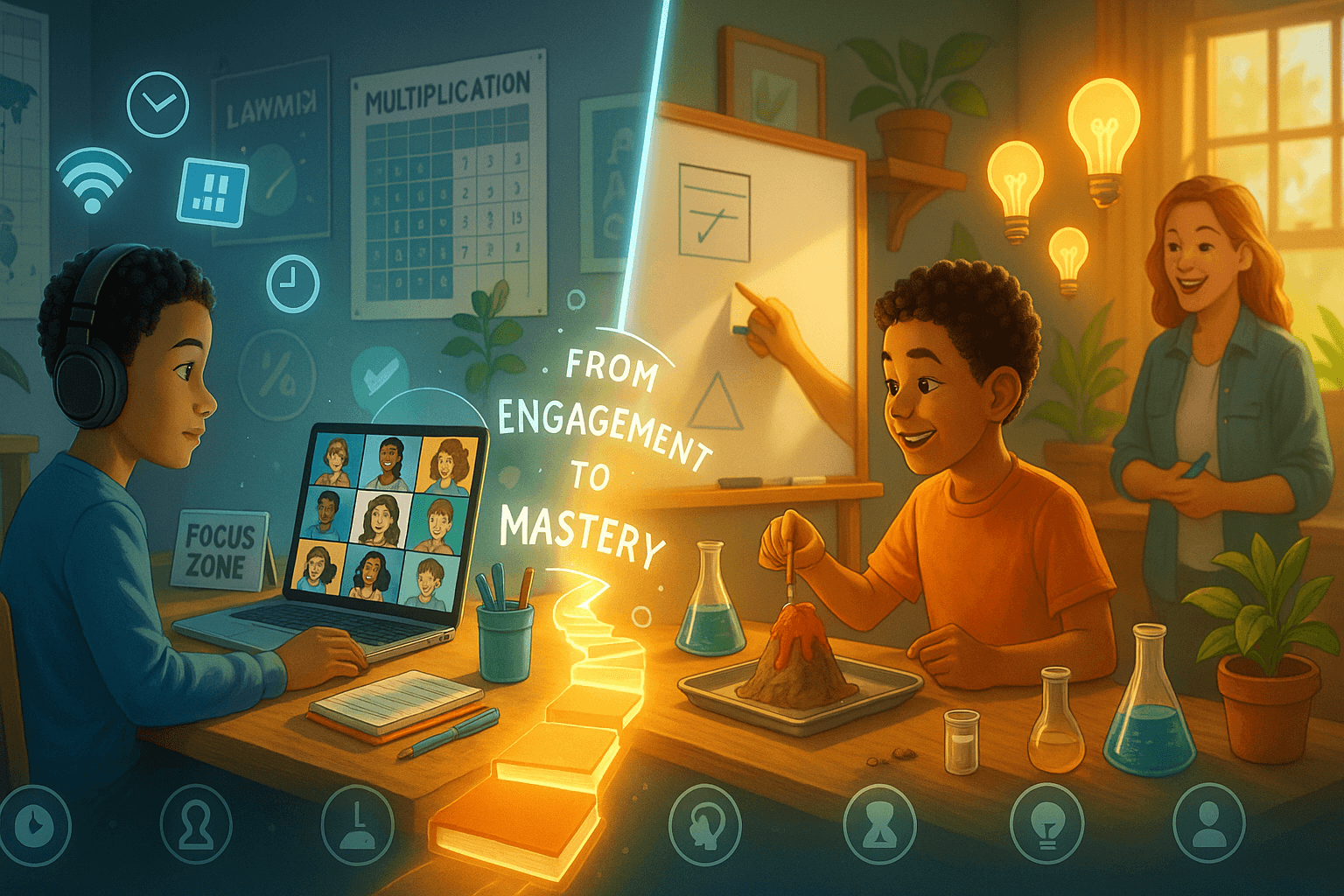
Moving beyond the screen is equally crucial. Encouraging your child to use what they learn online helps them understand better. They can explain, create, practice and connect lessons to real life. This changes passive watching into active learning, just like in a real class.
From applying these techniques, a parent becomes very powerful. Now, instead of waiting to see what a child is learning, he/she knows his/her child is receiving a good education. It also imparts very essential skills to children, such as critical thinking, communication, and good time management, ensuring a child's experience in online school beyond simply entering.
Learning During Online Class – FAQs
What are some practical ways to monitor my child's learning online?
Start with simple goal trackers. Help your child set 2-3 weekly goals. For example, ask them to "Finish math assignments by Friday" or "Ask one question during class." Also, review your online course platform together. Check participation stats and teacher feedback on submitted work.These steps are great for monitoring your child’s learning online and ensuring consistent learning during online class.
For example, say, "Show me how you solved that math problem." Try something better than just asking, "How was class?" Have them do hands-on reviews. For example, they can build a model of a cell after biology. These methods reveal true understanding for the average student without quizzes. Track progress every 10–14 days.
How can I tell if my child is really learning during online class?
Look beyond the screen. Does your child lean forward during live class discussions? Do they volunteer answers among their peers or type questions in discussion forums? After class, ask them to explain a concept in their own words, this is a strong indicator of learning during online class.
For example, they could describe how volcanoes erupt after a science lesson. Watch for lightbulb moments: "Mom, this math pattern is like my Lego tower" Check student work for applied knowledge, not just right answers. Real learning shows when they use fractions while baking or identify insects in the yard. Retention beats perfect test scores every time.
Which online class engagement tips are most effective for younger kids?
Younger students need movement and engagement with their peers :
Every 30 minutes, take short breaks to move around
Use visual timers (like a sand timer or an app) to help them see the difference between "focus time" and "play time".
Lessons should be experiential in nature. Count cereal pieces in math. Use toy cars to learn physics.
Praise their effort : Say something like, "You were really brave to raise your hand". On Fridays, let them use a pet rock for show-and-tell. This way, they can practice using descriptive words. Simple rewards, like extra story time, motivate kids to join in without screens.
These methods build engagement while improving learning during online class outcomes.
How can I improve my child’s online learning outcomes consistently?
Start a daily routine: Set a fixed schedule with the same login time each day to build consistency, work from a designated space, and take planned 5-minute short breaks every 30 minutes to keep energy levels up.
Make learning fun with activities: For math, measure ingredients. Like "Let’s triple this cookie recipe", Chart the weather for science.
Collaborate with teachers: Share your daily learnings at home. For example, "Adya understood percentages with pizza slices". Ask for feedback Like "What skills I need to practice at home?" Celebrate small wins, like finishing the assignments before dinner. This helps to build your confidence.
These habits consistently support improving online learning outcomes, increase virtual classroom effectiveness, and make learning during online class more impactful.
How often should I connect with teachers to monitor my child’s learning online?
It's best to have monthly check-ins about the Learning. You could send quick sample emails like "What skills does Sam need to practice?" or "How can we support this month's learning goals?". If you need some extra support, consider scheduling 15-minute meetings with your teachers every two weeks. School websites usually have information about how students are doing in their schoolwork.
Why is goal-setting important for online class engagement?
Goals turn passive screen time into active learning. Start small: "Raise your hand once in today's class" or "Finish one assignment before lunch." Kids track their progress on a wall chart. Each completed goal earns a sticker. This best method builds an inclusive environment where effort shines in various online programs.
A child who says, "Join 2 discussion forums this week," takes charge of their growth in distance learning. Hitting small goals boosts confidence for tougher challenges ahead. Over time, they become self-motivated learners who chase challenges, not just completion.
Comments
Your comment has been submitted successfully!